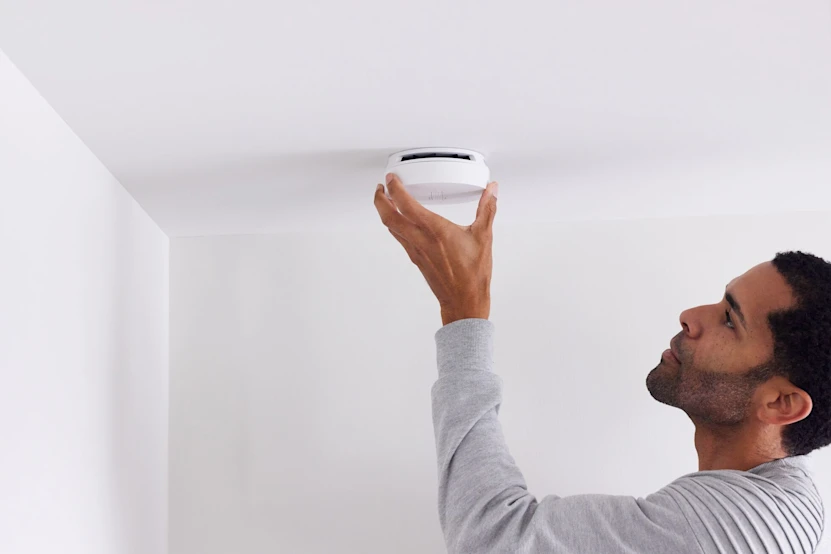A Comprehensive Carbon Monoxide Detector Guide
Posted October 10th, 2024 by SimpliSafe

Protecting your home from hazards like fires and carbon monoxide poisoning is just as important as protecting it from intruders. Many smart home security systems recognize this, and many of their offerings include everything from temperature sensors to smoke alarms and carbon monoxide detectors. Most people understand how dangerous carbon monoxide (CO) is. It’s odorless and colorless. People in the home can inhale it if there’s a leak, which can be deadly.
Therefore, the easiest and safest way to protect your home and family from the “silent killer” is by installing carbon monoxide detectors throughout the home. In this comprehensive guide, we will explore the importance of carbon monoxide detectors, where to place them, how to install them, and more:
What gives off carbon monoxide?
The first step in protecting your family from carbon monoxide is to know where the potential danger resides inside your home. This can help you install a detector in the right areas. In basic terms, a carbon monoxide (CO) leak happens when too much of the colorless and odorless gas is released into an enclosed space due to faulty combustion. CO exposure often stems from malfunctioning fuel-burning appliances like furnaces or car engines. Other common sources of carbon monoxide in homes include:
Gas or oil furnaces
Gas water heaters
Fireplaces and wood-burning stoves
Gas stoves and ovens
Generators
Automobile exhaust from an attached garage
Where should I place a carbon monoxide detector?
Investing in carbon monoxide detectors is a smart first step to keeping your family safe. But it’s also important to know how to install them properly. If not, they may not function as they should, which can be unsafe.
So, where should you put carbon monoxide detectors? The guidelines are simple: install at least one CO detector on every level of your home, including the basement. Having more than one means that carbon monoxide won’t go undetected. It also means that if one of the detectors is malfunctioning, another one will hopefully be able to pick up the leak.
It’s important to place the carbon monoxide detector near bedrooms in case a leak happens at night when everyone is sleeping. While it is not necessary to have a carbon monoxide detector in every room, it is recommended to have one near each sleeping area. For instance, if you have one bedroom on one side of the floor and one bedroom on the other side, you should consider placing a CO detector near both.
Lastly, the general rule of thumb is to install the detectors at least 15 feet away from fuel-burning appliances to prevent false alarms and ensure early detection. It’s not recommended to install one directly in the kitchen, for example, as nuisance alarms may go off.
Are there different types of carbon monoxide detectors?
Two types of carbon monoxide detectors are primarily available: battery-powered and hardwired.
Battery-powered detectors: These are easy to install and operate independently of your home's electrical system. They typically use replaceable batteries and are suitable for areas with frequent power outages.
Hardwired detectors: These are connected to your home's electrical system and often have a battery backup. They provide continuous monitoring and do not rely solely on batteries.
SimpliSafe offers a 2-in-1 Smoke and Carbon Monoxide Detector that alerts you when a dangerous hazard threatens your home. The product is engineered to sense the difference between dangerous smoke and burning food so that it only signals when there is a true emergency. Plus, with SimpliSafe’s award-winning security system and 24/7 professional monitoring, emergency assistance will be quickly sent to your front door whenever there’s trouble.
What to do if your CO detector goes off?
If your carbon monoxide detector’s siren goes off and you suspect the presence of carbon monoxide in your home, follow these steps immediately:
Evacuate: Quickly evacuate all occupants, including pets, from the premises. Move to fresh air outdoors and away from the potential source of carbon monoxide.
Call emergency services: Dial your local emergency number, fire department or gas company to report the situation. Remember, with SimpliSafe’s professional monitoring, you don’t have to worry about making this judgment alone. If your system picks up a leak, emergency services will be contacted automatically.
Know the warning signs of carbon monoxide poisoning: The purpose of having carbon monoxide detectors in your home is to be notified before you get poisoned. However, it’s still important to know the signs, as the gas is so dangerous. The two common warning signs of carbon monoxide poisoning are persistent headaches and flu-like symptoms such as dizziness, nausea, and fatigue. If you’re feeling any of these symptoms — especially if your alarm has gone off — seek medical attention immediately.
Do not re-enter the premises: It is vital not to re-enter the building until emergency responders have given clearance that it is safe to do so.
Address the leak: Once you know where the carbon monoxide leak came from, be sure to have a professional address the issue immediately.
Every home should have carbon monoxide detectors, as they’re an easy way to protect your family against an avoidable tragedy. If you’re already thinking of investing in a smart home security system, adding a carbon monoxide detector to your package ensures that all your security devices are interconnected. Plus, with professional monitoring, you can have an added layer of security knowing that professionals will alert the appropriate authorities during a carbon monoxide emergency.